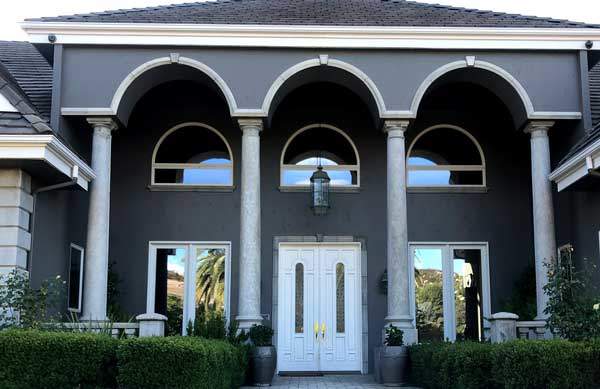How Residential Home Window Tinting Improves Your Home's Power Efficiency
Residential window tinting presents a compelling remedy for home owners looking for to enhance power efficiency within their living spaces. By applying specialized films to windows, it successfully lowers heat transfer, thereby stabilizing indoor temperatures and lessening the requirement for too much home heating or air conditioning.
Recognizing Home Window Tinting
Recognizing home window tinting is essential for homeowners seeking to enhance both comfort and power performance in their space. Residential Window Tint. Home window tinting entails the application of a slim movie to the inside or outside surface of glass windows. This film can significantly modulate the quantity of sunshine and warmth that goes into a home, therefore influencing indoor climate problems
There are numerous types of home window tinting films available, each with distinctive residential properties. The effectiveness of window tinting is usually determined by its Visible Light Transmission (VLT) percent, which suggests how much light can pass via the film.
Advantages of Energy Performance
Window tinting not just enhances aesthetic appeals but likewise plays a significant duty in improving power efficiency within property spaces. By minimizing heat transfer with home windows, tinted movies develop a much more secure indoor environment, which can bring about considerable decreases in energy usage for home heating and cooling. This power performance equates right into lower utility costs, providing house owners with substantial long-lasting financial savings.

Furthermore, window tinting enhances the convenience of living areas. By minimizing glow and blocking hazardous UV rays, tinted home windows create an even more pleasurable environment, which can bring about enhanced well-being for owners. The security versus UV rays likewise helps protect furniture and floor covering from fading, adding to the durability of house products.
How Tinting Functions
Tinting films run through a mix of advanced materials and technologies created to control the amount of solar power going into a home. Largely composed of polyester, these movies frequently include ceramic or metal fragments that absorb and show warmth. This dual capacity allows them to substantially reduce the penetration of ultraviolet (UV) rays and infrared radiation while allowing visible light to go through.
The performance of window tinting is determined by its solar warmth gain coefficient (SHGC), which indicates exactly how much solar power is transmitted with the home window. Reduced SHGC values are more effective as they represent greater warm denial. Additionally, window tints can include a selection of shades, allowing house owners to tailor their aesthetic preferences while improving power performance.
Furthermore, these films serve as an obstacle, preventing heat loss during cooler months by showing indoor heat back into the living area. This thermal insulation impact matches the air conditioning advantages obtained throughout warmer months, additional reading adding to a balanced indoor climate year-round. By managing solar power efficiently, property home window tinting not only improves comfort yet additionally plays a vital role in reducing power intake and decreasing energy costs.
Selecting the Right Color

There are different kinds of home window films readily available, consisting of dyed, metalized, and ceramic. Ceramic films offer exceptional warmth control without compromising presence and are very long lasting, making them a prominent choice.
Noticeable light transmission (VLT) is an additional crucial element, as it indicates the amount of natural light that can go through the tinted glass. House owners need to pick a color with a VLT that enhances their lights choices while still supplying appropriate glow decrease.
Furthermore, examining the solar warm gain coefficient (SHGC) can assist identify how well a tint can obstruct warmth from sunshine. A reduced SHGC indicates far better warm control, eventually improving energy efficiency.
Installation and Upkeep Tips
Appropriate installation and upkeep are crucial elements in taking full advantage of the benefits of household home window tinting. To achieve optimum results, it is advisable you can find out more to work with a qualified professional for setup. This guarantees that the color is applied correctly, staying clear of air bubbles, wrinkles, or imbalance that could endanger performance. Specialists likewise make use of specialized methods and tools, which can improve the sturdiness and performance of the tint.
Following setup, upkeep is important to lengthen the life of the home window film. It is suggested to wait at the very least 30 days prior to cleaning the colored windows to enable the sticky to cure completely. When cleansing, use a soft cloth and a gentle, ammonia-free cleaner to stay clear of harming the film. Avoid rough products that might damage the surface area.
Attending to these problems quickly can avoid further damage and keep power effectiveness. By adhering to these installation and maintenance pointers, home owners can guarantee their window tinting continues to offer significant energy cost savings and comfort for years to come.
Conclusion
In verdict, domestic home window tinting offers as an efficient remedy for enhancing power performance within homes. By decreasing warmth transfer and blocking dangerous UV rays, home window films add to decrease energy usage and boosted interior comfort.
Window tinting entails the application of a slim film to the interior or outside surface area of glass home windows. By decreasing warm transfer via home windows, tinted films produce an extra stable indoor climate, Go Here which can lead to substantial reductions in energy usage for home heating and air conditioning.The performance of window tinting is determined by its solar warm gain coefficient (SHGC), which shows exactly how much solar energy is transferred via the home window. By managing solar energy efficiently, household home window tinting not just boosts convenience but also plays an important function in minimizing power usage and reducing energy expenses.
By minimizing warmth transfer and obstructing hazardous UV rays, window films contribute to lower power intake and boosted interior convenience.